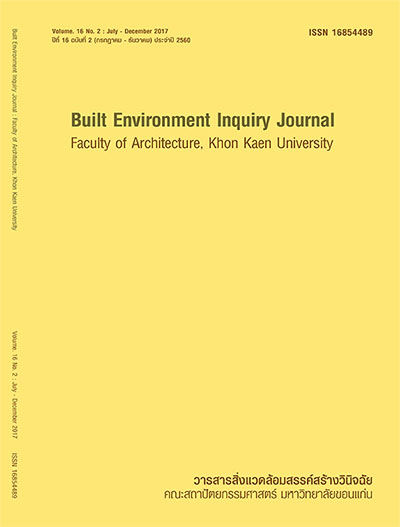สัมภาระทางวัฒนธรรมที่ปรากฏในเรือนยวนสีคิ้ว: จากเมืองเชียงแสนสู่จังหวัดนครราชสีมา-The Cultural Baggage of Sikhio Yuan House: from Chiang Saen to Nakhon Ratchasima
คำสำคัญ:
เรือนไตยวน, เรือนพื้นถิ่น, สัมภาระทางวัฒนธรรม, ยวนสีคิ้ว, ไตยวนบทคัดย่อ
บทคัดย่อ
บทความนี้มุ่งศึกษารูปแบบและลักษณะเรือนพักอาศัยของชาวไตยวนในอำเภอสีคิ้ว จังหวัดนครราชสีมา ดำเนินการโดยเก็บข้อมูลจากเรือนที่มีอายุระหว่าง 80-100 ปี จำนวน 4 หลัง ใช้วิธีการสังเกต รังวัดทางสถาปัตยกรรม สัมภาษณ์ประชากรในชุมชน และเปรียบเทียบกับเรือนไตยวนในภาคเหนือ ผลการศึกษาพบว่า เรือนพักอาศัยดั้งเดิมของชาวยวนสีคิ้วเป็นเรือนขนาดสองห้อง สร้างด้วยไม้มะค่า วางตัวเรือนแบบขวางตะวัน มีลักษณะเป็น “กลุ่มเรือนสองหลังหรือสามหลังที่ปลูกชิดขนานกันและมีพื้นที่ใช้สอยติดต่อกัน” เรือนแต่ละหลังมีโครงสร้างเฉพาะแยกออกจากกัน ยกใต้ถุนสูงพ้นศีรษะ หลังคาทรงจั่ว มีปั้นลมแบบตัวเหงา และเปิดช่องลมที่หน้าจั่ว พื้นที่ใช้สอยภายในสอดคล้องกับประเพณีไตยวน สรุปว่า เรือนยวนสีคิ้วสามารถคงรูปแบบโดยรวมและแบบแผนการอยู่อาศัยภายในเรือนเอาไว้ใกล้เคียงกับเรือนไตยวนหรือเรือนกาแลในภาคเหนือ พร้อมกับได้ปรับปรุงรูปแบบและเทคนิคก่อสร้างบางประการให้สอดคล้องกับบริบทแวดล้อมใหม่ที่แตกต่างไปจากเขตวัฒนธรรมล้านนาดั้งเดิม จนเกิด เป็นเรือนไตยวนสีคิ้วซึ่งมีลักษณะโดดเด่นเฉพาะตัว
Abstract
This article aimed to investigate forms and characteristics of Tai-yuan houses in Sikhio District, Nakhon Ratchasima, Thailand. Data was collected from four houses aged between 80 and 100 years by observation, architectural measure work, interview of the community’s population, and comparison with Tai-yuan houses in Northern region. The results showed that Sikhio’s Tai-yuan people’s traditional houses were “Reuan Song Hong” (two-column-span bedroom) ones made of ormosia wood, were positioned facing north to south (were oriented with long sides facing east and west), and were characterized as “a double or triple gable roof house group with two or three buildings built close and parallel to one another with functional areas connected to one another.” Each house had a specific structure separated from one another. It was raised off the ground on stilts to around head height, leaving an open space under the house. Further, it had a gable roof, gable ends with Ngou, and triangular end ventilation. Functional areas were also consistent with Tai-yuan tradition. In summary, Sikhio’s Tai-yuan houses were able to keep the overall forms and the living arrangements in the houses so closely with those of Tai-yuan houses or Galae houses in Northern region. Certain forms and construction techniques of Sikhio’s Tai-yuan houses were also improved for consistency with new contexts differing from traditional Lanna cultural areas such that Sikhio’s Tai-yuan houses with certain outstanding characteristics resulted.
ดาวน์โหลด
เผยแพร่แล้ว
รูปแบบการอ้างอิง
ฉบับ
ประเภทบทความ
สัญญาอนุญาต
ทัศนะและข้อคิดเห็นของบทความที่ปรากฏในวารสารฉบับนี้เป็นของผู้เขียนแต่ละท่าน ไม่ถือว่าเป็นทัศนะและความรับผิดชอบของกองบรรณาธิการ




